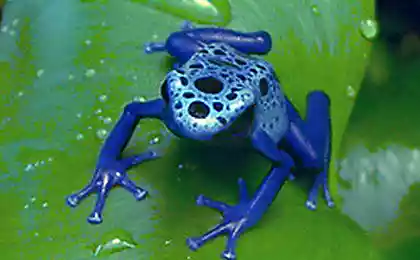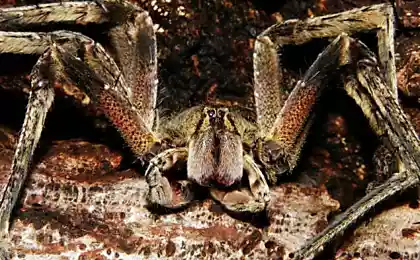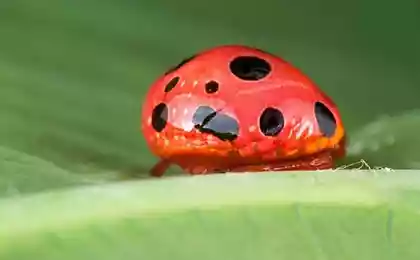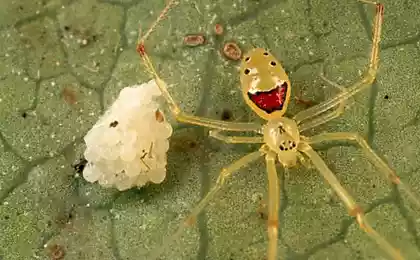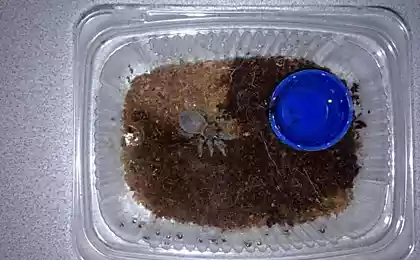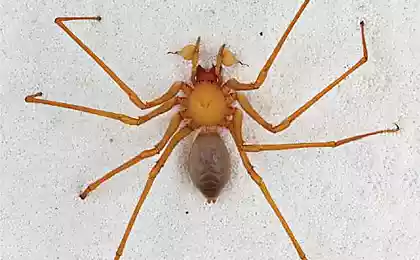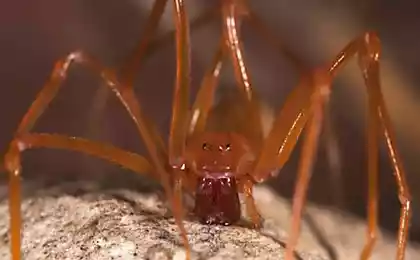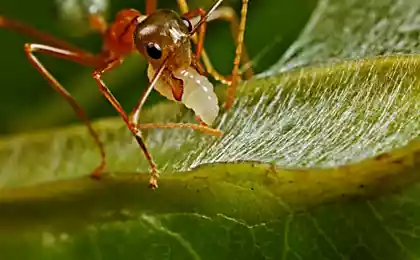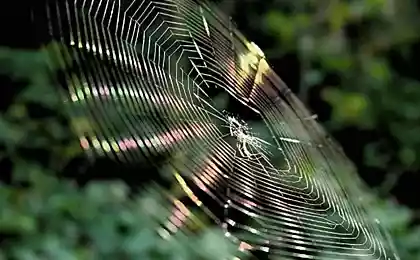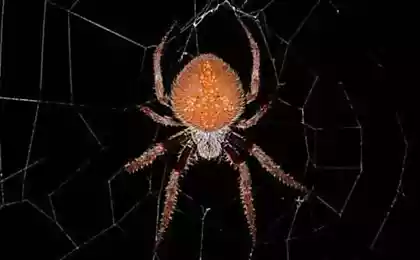1780
Darwin's bark spider
Recently opened and described in detail the form of spiders Caerostris darwini (Darwin's bark spider) is striking the best minds in science. About 10 years held arachnology scientists in national parks Andasibe, Ranomafana Mantadiya and located on the island of Madagascar, studying the life of this particular species.
And he drew attention, first of all, his spider web - arthropods representatives Darwin spiders weave incredible size of the network - the largest area of the fixed traps - 3 square meters. Scientists claim that this is not the limit - if not today, tomorrow and show up larger in size Web.
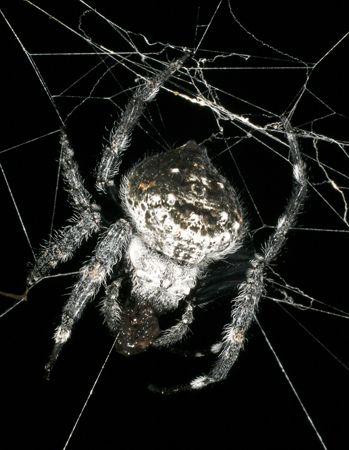
Darwin's bark spider stretches its network of streams and lakes.
Darwin's bark spider was first found on the island of Madagascar. This island country is located in close proximity to the African continent, it is famous for its unique wildlife and exotic flora and fauna. Madagascar - favorite work platform of experts from various fields of science, the island territory annually visited by hundreds of zoologists, botanists and other, more specialists in the natural sciences, however, this species was found and taxonomically described only in 2010. This seems odd, because these sizes pautinovye network should not have to remain undetected for so long.
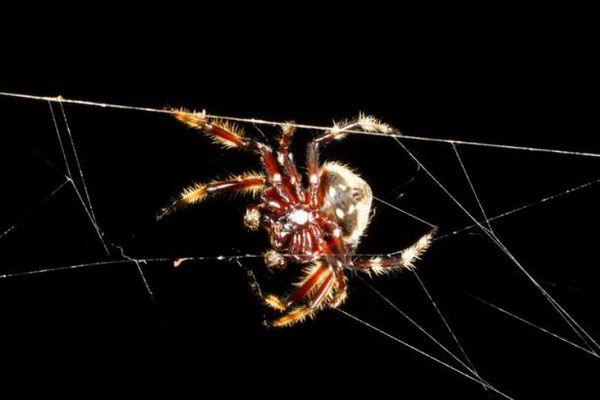
Created spider network the imagination with its size. For comparison result report, scientists scope gimp (main bearing thread), which reaches over the water in the form of a stretched length of 25 m! Circles, weave in the gimp, reaching record sizes in diameter - from 1 to 2 meters! A strength of the yarn exceeds the strength synthetic fiber Kevlar, the modern heavy-duty and very light material used in high-tech aviation and automotive industry. Representatives of this kind of stretch its network of streams and small rivers. The resourcefulness of the spiders can not refuse, because it takes place on the water bodies active movement of insects. During the study were counted more than 30 species of a variety of insects caught by this species of spiders. Moreover, the representatives-track the birds are often the victims of arranged traps. Despite the size of a spider network rather modest appetites, all fall into the trap insects do not eat it, and here it come to the aid of local nimble flies, they share a meal with the spider, thus creating yet another unique example of interspecies symbiosis.
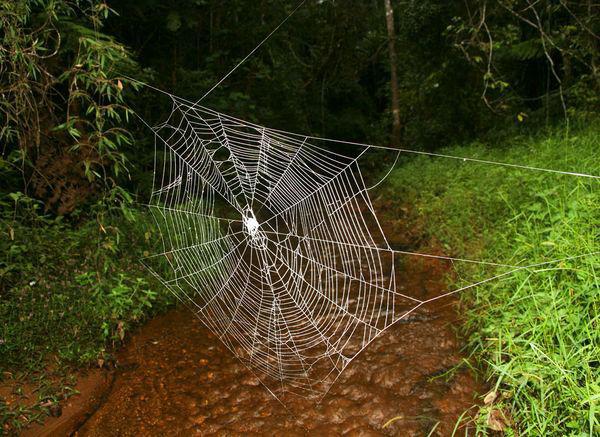
Moths fall in the network - the main diet of spider Darwin.
View Caerostris darwini (Darwin's bark spider) has been studied in two arachnology Inga Angarson and Mathias Kuntner (Ingi Angarsson and Matjas Kuntner). Spider has attracted the attention of scientists in 2001, for several years took him to a large-scale study of members of the species, and even for some time on his description. In addition to unique size and properties of its web spiders were in a group of representatives of arthropods have a pronounced sexual dimorphism - the female spider is three times larger in size than males (females reach sizes up to 18 mm, the males - 6 mm). Report on a new spider was deliberately timed to coincide with the 150th anniversary of Charles Darwin, Darwin was the first to propose the theory of sexual selection explains the sexual dimorphism. From here begins the story of the name of the spider - in honor of the famous traveler and naturalist.
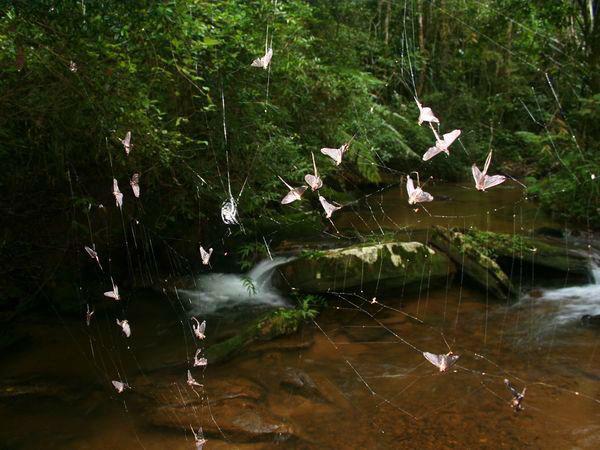
Darwin's bark spider - the right female left male - sexual dimorphism - the size of the female spider is much larger than the male.
In his work arachnology academic council made it clear that lifestyle spider Darwin is not fully open, view is extremely interesting and further study will allow to learn a lot not only about themselves, but also allow a breakthrough in modern technologies of production of heavy-duty, yet ultra-light materials. Preliminary structural analysis of the fiber web that held by the brought samples revealed that their structure and strength characteristics higher than those mentioned Kevlar 10 times! If our civilization learns to create these materials, humankind will make a breakthrough in many areas of science and technology.
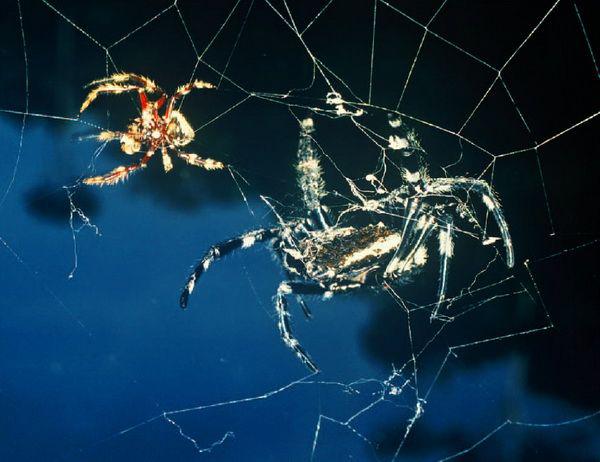
A source
And he drew attention, first of all, his spider web - arthropods representatives Darwin spiders weave incredible size of the network - the largest area of the fixed traps - 3 square meters. Scientists claim that this is not the limit - if not today, tomorrow and show up larger in size Web.

Darwin's bark spider stretches its network of streams and lakes.
Darwin's bark spider was first found on the island of Madagascar. This island country is located in close proximity to the African continent, it is famous for its unique wildlife and exotic flora and fauna. Madagascar - favorite work platform of experts from various fields of science, the island territory annually visited by hundreds of zoologists, botanists and other, more specialists in the natural sciences, however, this species was found and taxonomically described only in 2010. This seems odd, because these sizes pautinovye network should not have to remain undetected for so long.

Created spider network the imagination with its size. For comparison result report, scientists scope gimp (main bearing thread), which reaches over the water in the form of a stretched length of 25 m! Circles, weave in the gimp, reaching record sizes in diameter - from 1 to 2 meters! A strength of the yarn exceeds the strength synthetic fiber Kevlar, the modern heavy-duty and very light material used in high-tech aviation and automotive industry. Representatives of this kind of stretch its network of streams and small rivers. The resourcefulness of the spiders can not refuse, because it takes place on the water bodies active movement of insects. During the study were counted more than 30 species of a variety of insects caught by this species of spiders. Moreover, the representatives-track the birds are often the victims of arranged traps. Despite the size of a spider network rather modest appetites, all fall into the trap insects do not eat it, and here it come to the aid of local nimble flies, they share a meal with the spider, thus creating yet another unique example of interspecies symbiosis.

Moths fall in the network - the main diet of spider Darwin.
View Caerostris darwini (Darwin's bark spider) has been studied in two arachnology Inga Angarson and Mathias Kuntner (Ingi Angarsson and Matjas Kuntner). Spider has attracted the attention of scientists in 2001, for several years took him to a large-scale study of members of the species, and even for some time on his description. In addition to unique size and properties of its web spiders were in a group of representatives of arthropods have a pronounced sexual dimorphism - the female spider is three times larger in size than males (females reach sizes up to 18 mm, the males - 6 mm). Report on a new spider was deliberately timed to coincide with the 150th anniversary of Charles Darwin, Darwin was the first to propose the theory of sexual selection explains the sexual dimorphism. From here begins the story of the name of the spider - in honor of the famous traveler and naturalist.

Darwin's bark spider - the right female left male - sexual dimorphism - the size of the female spider is much larger than the male.
In his work arachnology academic council made it clear that lifestyle spider Darwin is not fully open, view is extremely interesting and further study will allow to learn a lot not only about themselves, but also allow a breakthrough in modern technologies of production of heavy-duty, yet ultra-light materials. Preliminary structural analysis of the fiber web that held by the brought samples revealed that their structure and strength characteristics higher than those mentioned Kevlar 10 times! If our civilization learns to create these materials, humankind will make a breakthrough in many areas of science and technology.

A source


